Search Result
Results for "
plasma cell
" in MedChemExpress (MCE) Product Catalog:
5
Biochemical Assay Reagents
1
Isotope-Labeled Compounds
| Cat. No. |
Product Name |
Target |
Research Areas |
Chemical Structure |
-
- HY-W142596
-
|
|
Liposome
|
Others
|
|
1,2-DImyristoyl-rac-glycero-3-phosphocholine (DMPC), a zwitterionic phospholipid, is chosen as a simple eukaryotic cell membrane, mimicking the neutral charge of the surface membrane of eukaryotic plasma membranes .
|
-
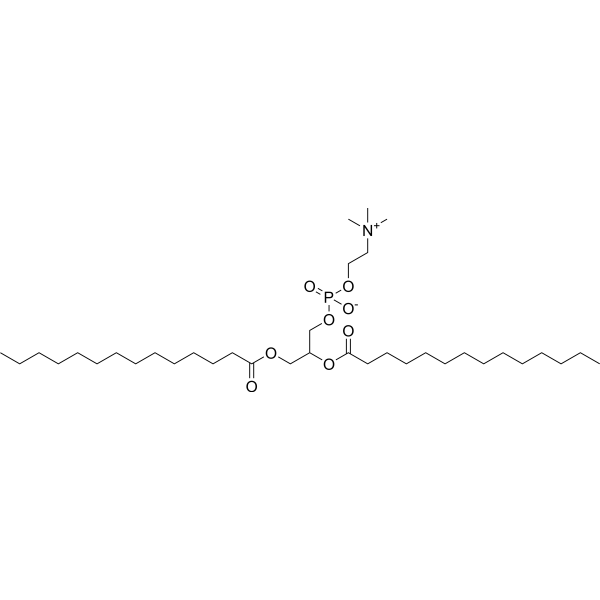
-
- HY-119594
-
|
|
Parasite
|
Infection
|
|
Melarsoprol, a melaminophenylarsine-type trivalent organic arsenical, is an important drug for African trypanosomiasis. Melarsoprol is also active against leukemia cell lines and plasma cells from myeloma patients. Melarsoprol increases the biliary output of GSH in rats .
|
-
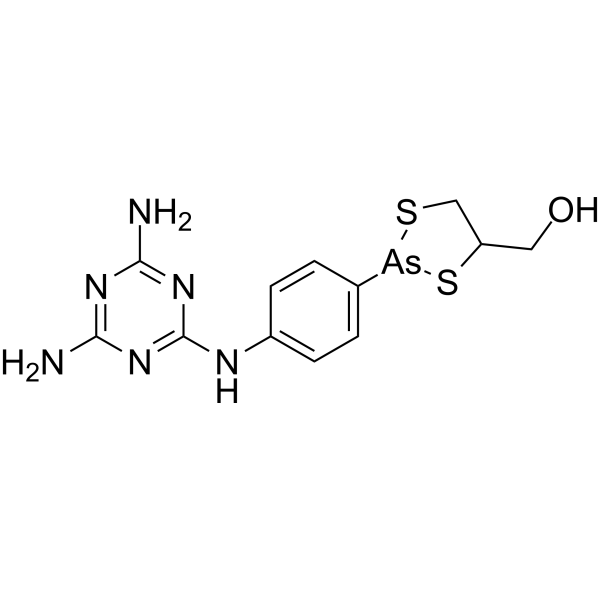
-
- HY-156404
-
|
|
Fluorescent Dye
|
Others
|
|
PM-1, a derivative of Thioflavin-T (ThT; HY-D0218), is a small but highly specific plasma membrane (PM) fluorescent dye for specific and long-time membrane imaging of living and fixed cells. PM-1 is embedded directly into the cell membrane and exhibits a very long retention time on the plasma membrane with a half-life of approximately 15 h. PM-1 can be used in combination with protein labeling probes to study ectodomain shedding and endocytosis processes of cell surface proteins .
|
-

-
- HY-NP011
-
|
TRF
|
Transferrin Receptor
|
Others
|
|
Human transferrin (suitable for cell culture) is a glycoprotein with a branched sugar chain that mediates the transport of iron from plasma to cells .
|
-

-
- HY-D2318
-
|
|
Fluorescent Dye
|
Others
|
|
Flipper-TR 5 is a Flipper probe that can selectively label the plasma membrane of cells and exhibit excellent mechanosensitivity with negligible cytotoxicity .
|
-

-
- HY-114297
-
|
|
Endogenous Metabolite
|
Others
|
|
Zymosterol is a Cholesterol (HY-N0322) biosynthesis metabolite. Zymosterol, a precursor of Cholesterol, is found mostly in the plasma membrane. Zymosterol circulates within the cell .
|
-

-
- HY-107781
-
-
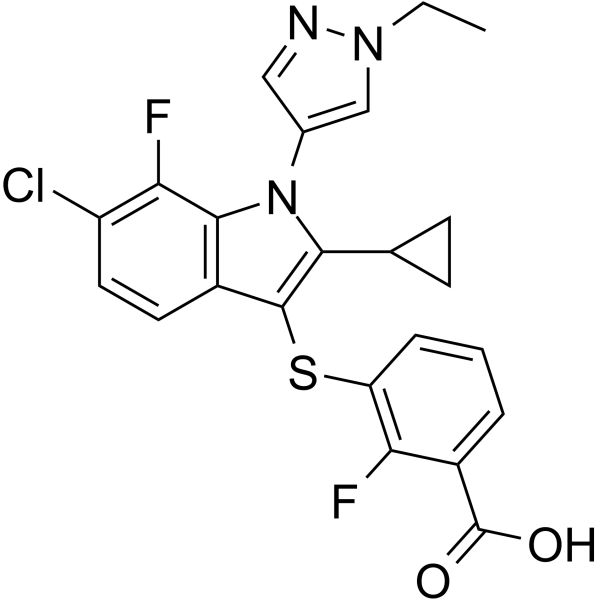
-
- HY-126378
-
|
|
Kallikrein
|
Inflammation/Immunology
|
|
LSP-249 (example 35), extracted from patent WO2016011209A1, is a plasma kallikrein inhibitor under the study for angioedema, with an EC50 less than 100 nM in cell .
|
-
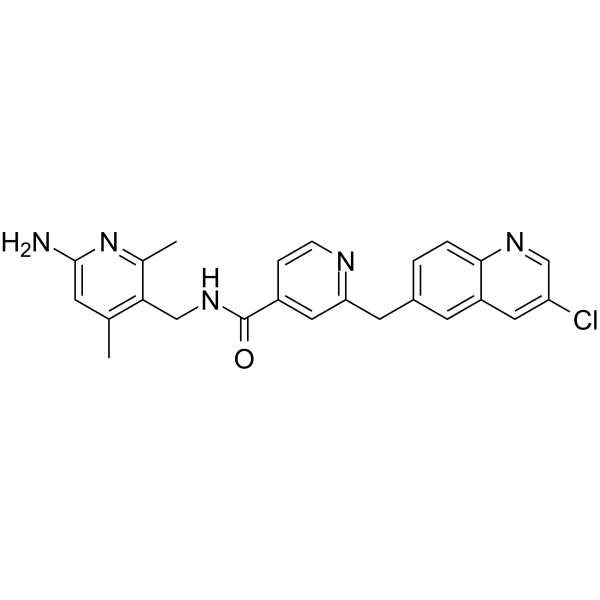
-
- HY-N7122
-
|
|
Endogenous Metabolite
|
Inflammation/Immunology
Cancer
|
|
Thymopentin is a biologically active peptide secreted mainly by the epithelial cells of thymic cortex and medulla. Thymopentin is an effective immunomodulatory agent with a short plasma half-life of 30 seconds. Thymopentin enhances the generation of T-cell lineage derived from human embryonic stem cells (hESCs) .
|
-
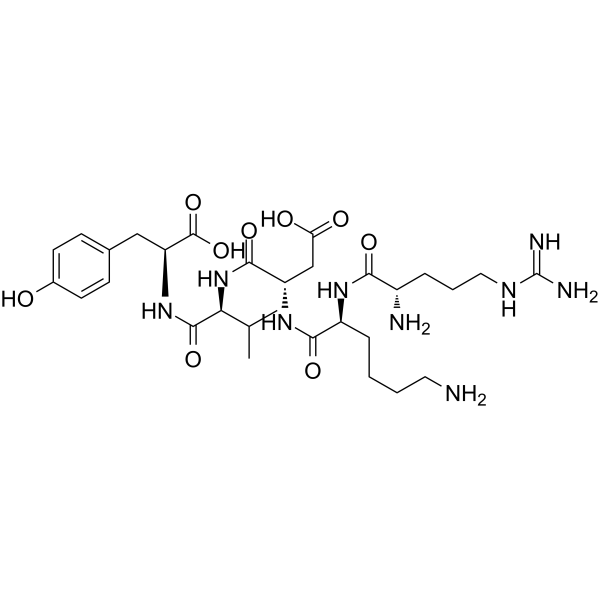
-
- HY-N7122A
-
|
|
Endogenous Metabolite
|
Inflammation/Immunology
Cancer
|
|
Thymopentin acetate is a biologically active peptide secreted mainly by the epithelial cells of thymic cortex and medulla. Thymopentin acetate is an effective immunomodulatory agent with a short plasma half-life of 30 seconds. Thymopentin acetate enhances the generation of T-cell lineage derived from human embryonic stem cells (hESCs) .
|
-
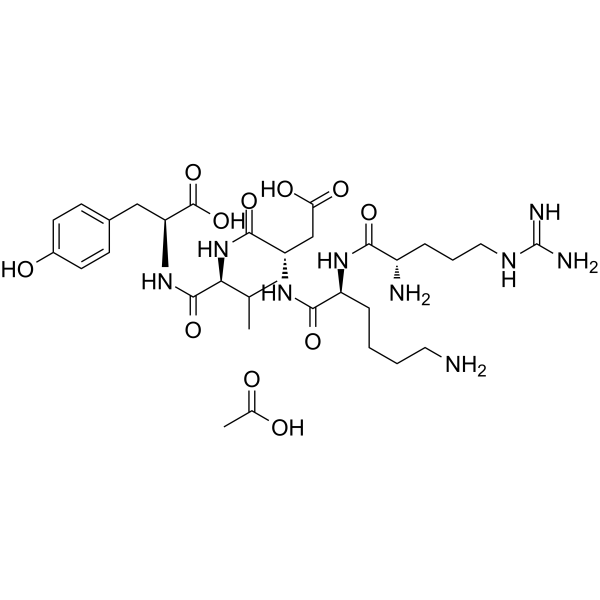
-
- HY-15924
-
Thiazolyl Blue
Maximum Cited Publications
102 Publications Verification
MTT; Thiazolyl Blue Tetrazolium bromide; Methylthiazolyldiphenyl-tetrazolium bromide
|
Fluorescent Dye
|
Others
|
|
Thiazolyl Blue (MTT) is a cell-permeable and positively charged tetrazolium dye that is used to detect reductive metabolism in cells. Thiazolyl Blue is taken up by cells through the plasma membrane and then reduced to formazan by intracellular NAD (P) H-oxidoreductases. Thiazolyl Blue is frequently used in colorimetric assays to measure cell proliferation, cytotoxicity, and apoptosis .
|
-

-
- HY-151284
-
|
|
Bacterial
Fungal
|
Infection
|
|
Antifungal agent 38 is a geterocyclic disulfide, an antifungal and antibacterial agent. Antifungal agent 38 induces the shrinkage of hyphae, disrupts the integrity of the plasma membrane, and causes the damage and leakage of cell contents .
|
-
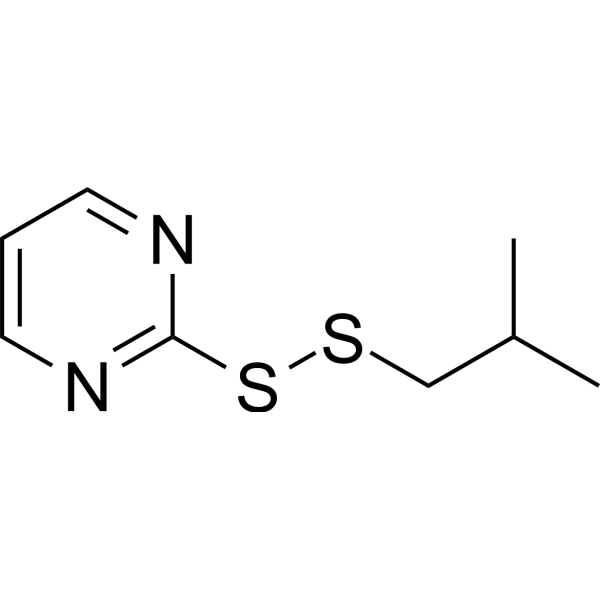
-
- HY-100432
-
LOC14
2 Publications Verification
|
PDI
|
Neurological Disease
Inflammation/Immunology
|
|
LOC14 is a potent Protein disulfide isomerase (PDI) inhibitor with EC50 and Kd values of 500 nM and 62 nM, respectively. LOC14 exhibits high stability in mouse liver microsomes and blood plasma, low intrinsic microsome clearance, and low plasma-protein binding .
LOC14 inhibits PDIA3 activity, decreases intramolecular disulfide bonds and subsequent oligomerization (maturation) of HA in lung epithelial cells .
|
-
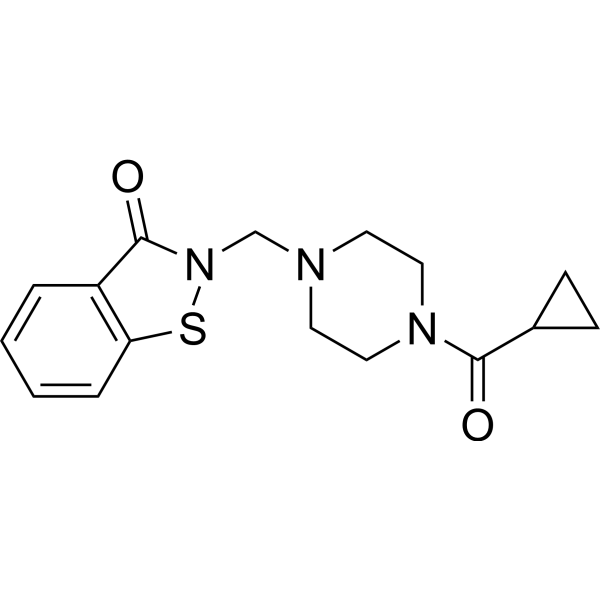
-
- HY-152102
-
|
|
Fluorescent Dye
|
Cancer
|
|
BTCy is a near-infrared (NIR) fluorescence probe with polarity-responsive and cell plasma membrane-targeting properties. BTCy can be used for in vivo imaging of tumor tissue (λex = 561 nm, λem = 600-700 nm) .
|
-
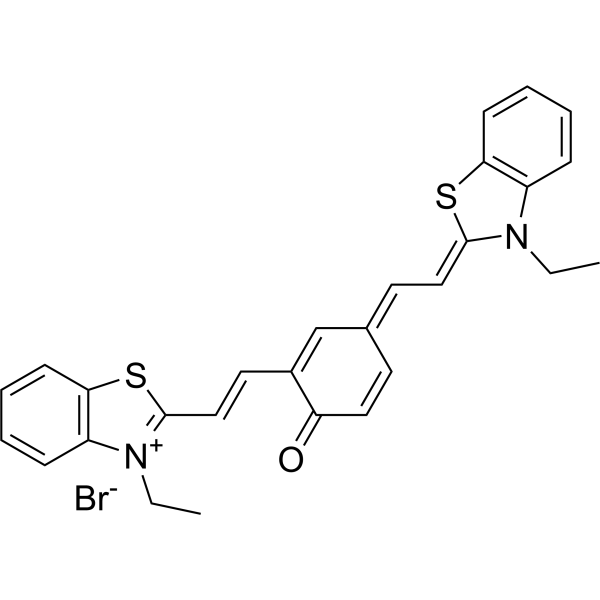
-
- HY-D2301
-
|
|
Fluorescent Dye
|
Others
|
|
mgc(3Me)FL is the active fluorescent form of mgc(3Me)FDA (HY-D2300) after hydrolysis in cells. mgc(3Me)FL subcellularly localizes to the Golgi apparatus and is a visualized Golgi probe. mgc(3Me)FL also binds to the outer leaflet of the plasma membrane (PM), causing the plasma membrane to fluoresce .
|
-
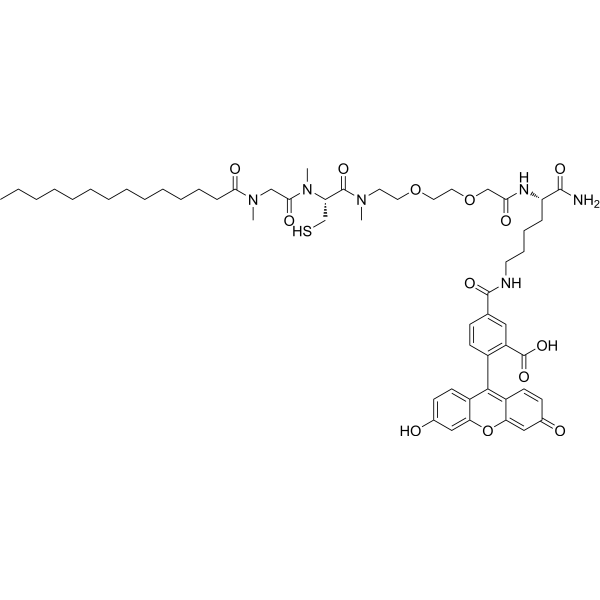
-
- HY-N4202
-
|
|
Mitochondrial Metabolism
Apoptosis
|
Neurological Disease
|
|
Dihydrorotenone, a natural pesticide, is a potent mitochondrial inhibitor. Dihydrorotenone probably induces Parkinsonian syndrome. Dihydrorotenone induces human plasma cell apoptosis by triggering endoplasmic reticulum stress and activating p38 signaling pathway .
|
-
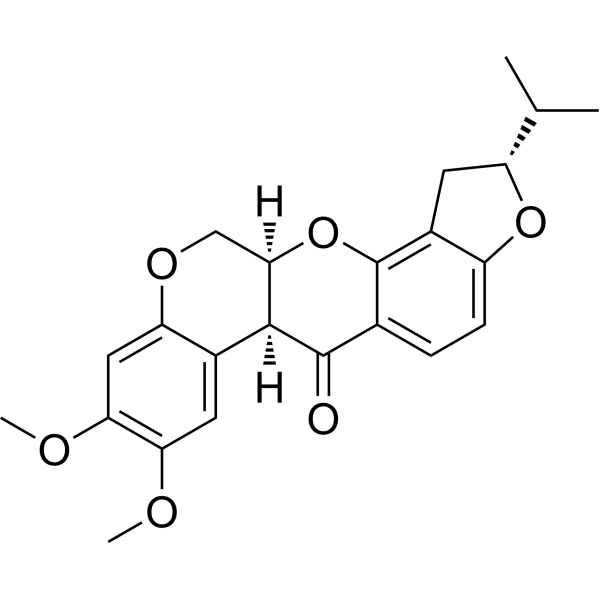
-
- HY-163462
-
|
|
Fungal
|
Infection
|
|
Poacic Acid is a plant-derived stilbenoid with an antifungal activity. Poacic Acid localizes to the yeast cell wall and disrupts the production and assembly of β-1,3-glucan in the fungal cell walls. Poacic Acid exhibits fungicidal activity to Saccharomyces cerevisiae and plasma membrane-compromised Candida albicans mutants .
|
-

-
- HY-NP018
-
|
FGA; FGA protein
|
NF-κB
|
Inflammation/Immunology
|
|
Bovine fibrinogen (from fibrinogen) is a native fibrinogen from bovine plasma. Bovine fibrinogen (from fibrinogen) can regulate the activation of NF-KB in endothelial cells and upregulate the expression of inflammatory chemokines MCP-1 .
|
-

-
- HY-19365
-
|
|
Adenosine Receptor
|
Neurological Disease
|
|
AB-MECA is a high affinity A3 adenosine receptor agonist with a binding Ki of 430.5 nM for human A3 receptors in CHO cells. AB-MECA can enhance plasma histamine level .
|
-

-
- HY-P4856
-
|
|
PKC
|
Endocrinology
|
|
pTH-Related Protein (1-40) (human, mouse, rat) stimulates calcium uptake in rat intestinal cells through PTHR1 receptor and PKCα/β signaling pathways. pTH-Related Protein (1-40) up-regulates parathyroid hormone 1 receptor (PTHR1) protein, four transcellular calcium transporters, potential vanillin member 6 (TRPV6), calcium-binding protein-D9K (CaBP-D9k), sodium-calcium Exchanger 1 (NCX1) and plasma membrane calcium ATPase 1 (PMCA1) .
|
-

-
- HY-D2263
-
|
|
Fluorescent Dye
|
Others
|
|
BODIPY-cholesterol conjugate-3 (compound 7) is a cholesterol analogue with a fluorescent BODIPY group. BODIPY-cholesterol conjugate-3 can be used to simultaneously visualize multiple cholesterol pools in cells, as it is primarily localized to the plasma membrane .
|
-

-
- HY-P9960
-
|
Ocrevus
|
CD20
|
Inflammation/Immunology
|
|
Ocrelizumab is an anti-CD20 antibody that depletes circulating immature and mature B cells but spares CD20-negative plasma cells. The effector mechanisms of Ocrelizumab are complement-dependent cytotoxicity and antibody-dependent cellular cytotoxicity. Ocrelizumab is the first monoclonal antibody for secondary primary progressive multiple sclerosis (PPMS) .
|
-
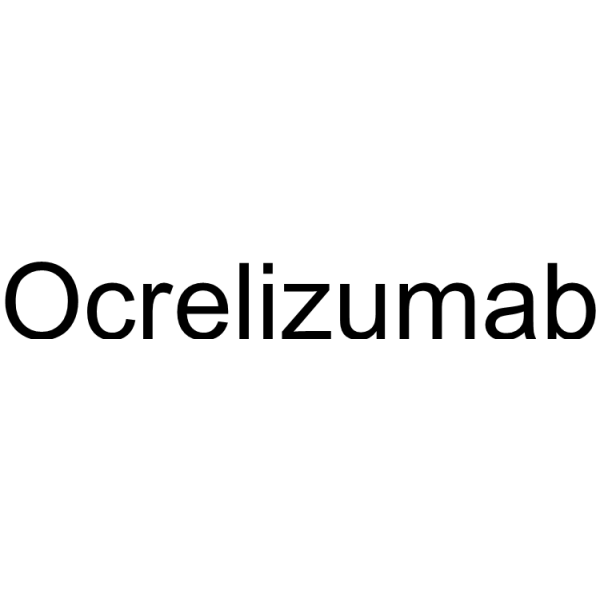
-
- HY-D0986
-
|
|
Fluorescent Dye
|
Others
|
|
TMA-DPH is a hydrophobic fluorescent membrane probe (Ex=355 nm; Em=430 nm). TMA-DPH is able to anchor on the cell surface and localize to different regions of the phospholipid bilayer. By analyzing the fluorescence polarization values of TMA-DPH in the plasma membrane and membrane substructures, the fluidity of the cell membrane can be determined .
|
-

-
- HY-136213
-
|
|
Fluorescent Dye
|
Others
|
|
Endoplasmic reticulum dye 1 is a promising live cell imaging agent for the detection of exocytotic events at the plasma membrane. Endoplasmic reticulum dye 1 shows low cytotoxicity, resistance to photobleaching , which is ideal for imaging either short- or long-time courses .
|
-
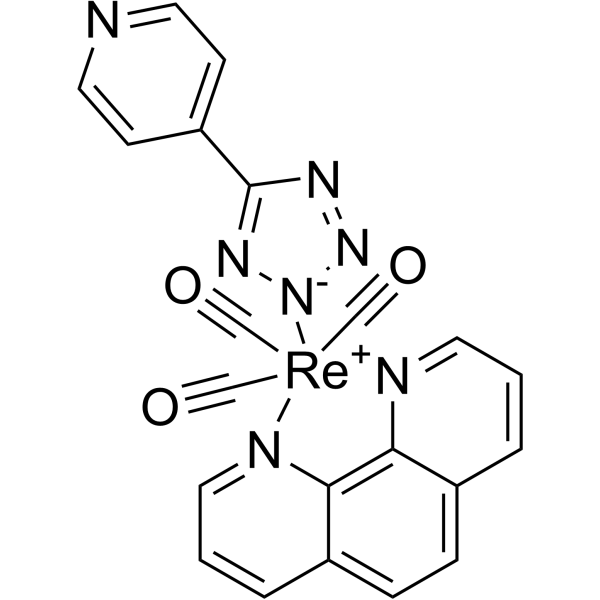
-
- HY-106938
-
|
WAY-ACA 147
|
Acyltransferase
|
Cardiovascular Disease
Metabolic Disease
|
|
Eldacimibe is an ACAT2 inhibitor. Eldacimibe can lower plasma cholesterol levels by blocking cholesterol absorption and can prevent macrophages from turning into foam cells. Eldacimibe can be used in the study of cardiovascular diseases (atherosclerosis), endocrine and metabolic diseases (hypercholesterolemia) .
|
-

-
- HY-P1956
-
|
HSA
|
NF-κB
NO Synthase
|
Cardiovascular Disease
Inflammation/Immunology
|
|
Human serum albumin (HSA) is the most abundant protein in plasma and is a major determinant of plasma oncotic pressure. Human serum albumin exhibits antioxidant, anticoagulant, anti-inflammatory, anti-platelet aggregation activities as well as colloid osmotic action. Human serum albumin can block the inhibitory effect of GML on human T cells, providing protective function for T cells. Human serum albumin is also associated with cardiovascular diseases and can partially prevent the LPS (HY-D1056) induced oxidative stress, as well as the upregulation of NF-κB, NF-κB, and peroxynitrite (ONOO −) in the vascular wall, contributing to the reduction of blood pressure .
|
-

-
- HY-P1923
-
|
L-ASNase
|
Apoptosis
DNA/RNA Synthesis
|
Cancer
|
|
L-Asparaginase (L-ASNase) is a deamidating enzyme that catalyses the hydrolysis of L-asparagine and L-glutamine, and can be used for the research of acute lymphoblastic leukemia. L-Asparaginase depletes L-asparagine from plasma resulting in inhibition of RNA and DNA synthesis with the subsequent blastic cell apoptosis .
|
-
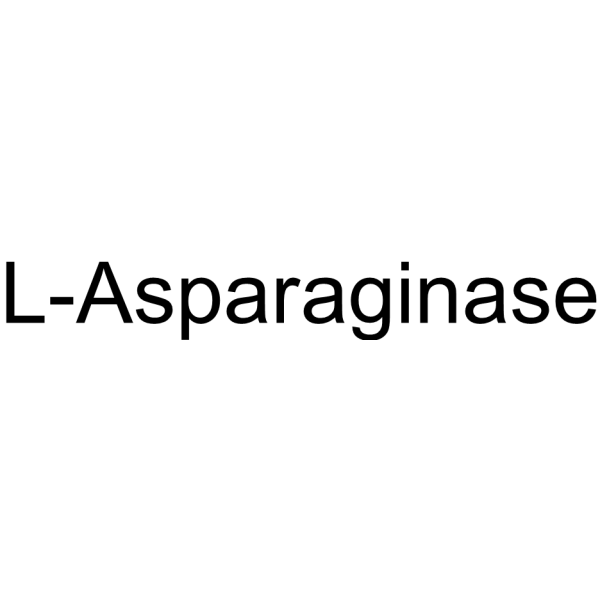
-
- HY-D1585
-
|
|
Fluorescent Dye
|
Others
|
|
BODIPY TR methyl ester is a lipophilic GFP Counterstain. BODIPY TR methyl ester dye readily permeates cell membranes and localizes in endomembranous organelles but not localize strongly in plasma membranes. BODIPY TR methyl ester is an excellent red fluorescent vital dye (Ex=568 nm, Em=625 nm), can be used to reveal the location and shapes of cell nuclei, the shapes of cells within embryonic tissues, as well as the bound aries of organ-forming tissues within the whole embryo .
|
-
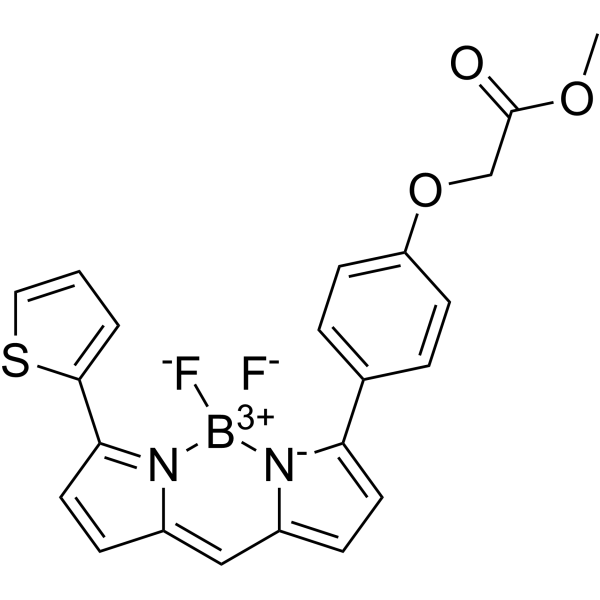
-
- HY-122357
-
|
|
Adenylate Cyclase
|
Inflammation/Immunology
|
|
Bestim is a dipeptide, which exhibits high affinity to murine peritoneal macrophages, thymocytes, and plasma membranes isolated from these cells, with Kds of 3.1, 2.1, 18.6 and 16.7 nM, respectively. Bestim inhibits adenylate cyclase in the membranes of murine macrophages and thymocytes. Bestim exhibits immunomodulatory efficacy .
|
-

-
- HY-143458
-
|
|
FAK
PROTACs
|
Cancer
|
|
FAK PROTAC B5 (Compound B5) is a FAK PROTAC degrader with an IC50 value of 14.9 nM. FAK PROTAC B5 presents strong FAK degradation activity, antiproliferative activity, outstanding plasma stability and moderate membrane permeability. FAK PROTAC B5 inhibits cell migration and invasion .
|
-

-
- HY-130602
-
|
|
PROTACs
MEK
|
Cancer
|
|
MS432 is a first-in-class and highly selective PD0325901-based von Hippel-Lindau-recruiting PROTAC degrader for MEK1 and MEK2. MS432 displays good plasma exposure in mice, exhibiting DC50 values of 31 nM and 17 nM for MEK1, MEK2 in HT29 cells respectively .
|
-
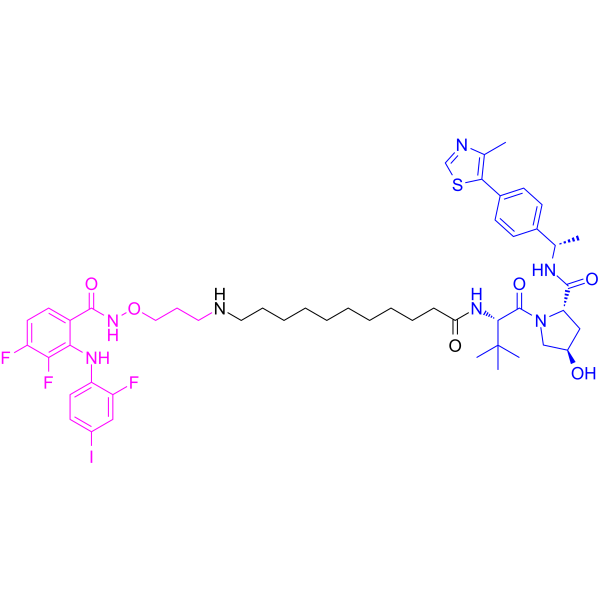
-
- HY-155742
-
|
|
CFTR
|
Others
|
|
CFTR corrector 12 (compound 17C) is a bithiazole derivative, serving as CFTR corrector. CFTR corrector 12 has the ability to correct some folding defective mutants of the channel responsible for the control of chloride transport across the plasma membrane. CFTR corrector 12 recovers the α-sarcoglycan (α-SG) content in mutant cells .
|
-
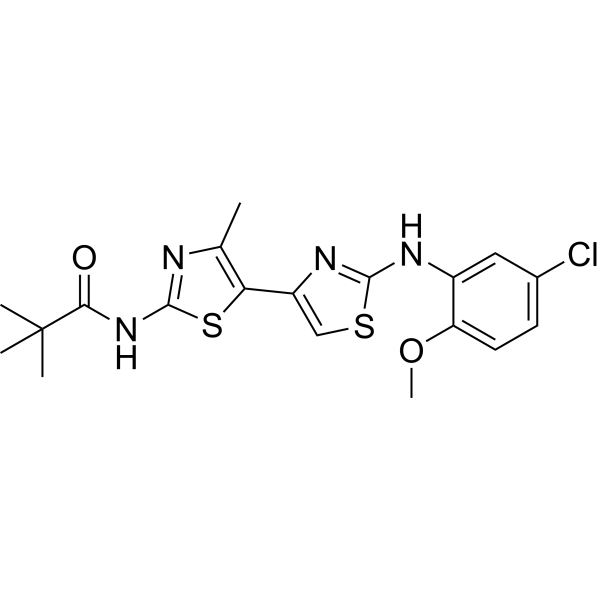
-
- HY-128943
-
|
|
Drug-Linker Conjugates for ADC
|
Cancer
|
|
MAC glucuronide phenol-linked SN-38 is a pH-susceptible lactone MAC glucuronide phenol-linked SN-38 (DNA topoisomerase I inhibitor) agent linker. MAC glucuronide phenol-linked SN-38 is cytotoxic across L540cy cells and Ramos cells with IC50 values of 113 and 67 ng/mL, respectively.Albumin-coupled MAC glucosidol-linked SN-38 shows good stability in mouse plasma .
|
-
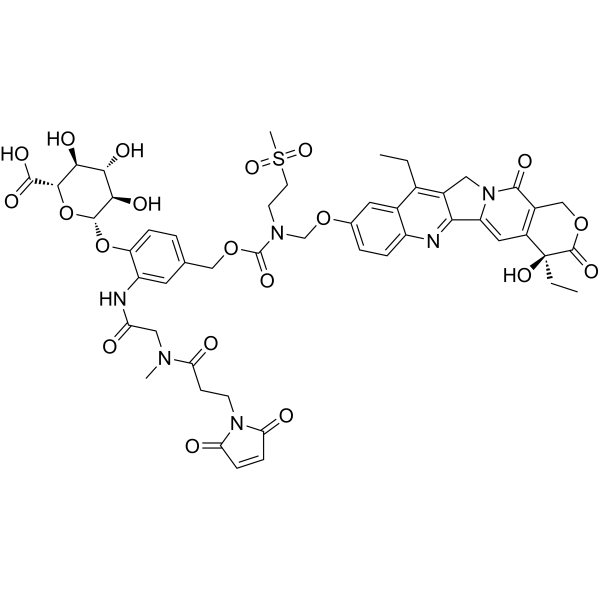
-
- HY-149917
-
|
|
Itk
|
Cancer
|
|
ITK degrader 1 is a highly selective degrader of interleukin-2-inducible T-cell kinase (ITK; DC50=3.6 nM in vivo in mice). ITK degrader 1 induces rapid, and prolonged ITK degradation and suppresses IL-2 secretion (EC50=35.2 nM, Jurkat cells) stimulated by anti-CD3 antibodyin vivo. ITK degrader 1 also shows good plasma exposure levels .
|
-
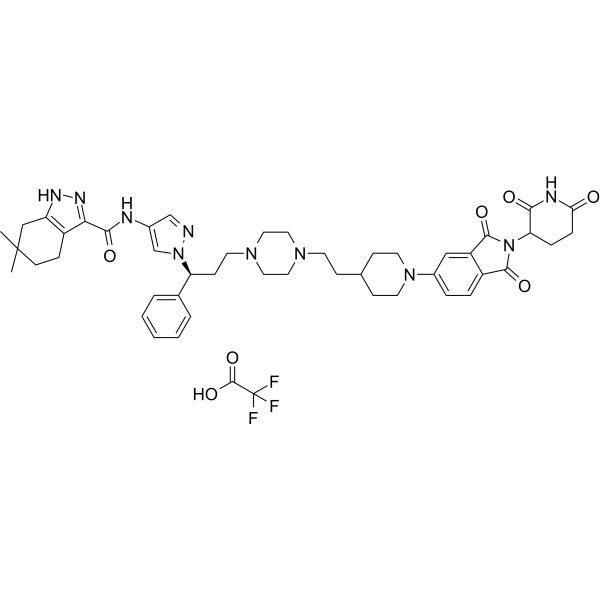
-
- HY-P1446
-
|
Choleragen
|
Adenylate Cyclase
|
Inflammation/Immunology
|
|
Cholera toxin (Choleragen), an AB(5)-subunit toxin, enters host cells by binding the ganglioside GM1 at the plasma membrane (PM) and travels retrograde through the trans-Golgi Network into the endoplasmic reticulum (ER) . Choleragen activates adenylate cyclase by catalyzing ADP-ribosylation of Gs alpha, the stimulatory guanine nucleotide-binding protein .
|
-

-
- HY-160214
-
|
|
Others
|
Inflammation/Immunology
|
|
Perforin-IN-2 is a benzosulfonamide perforin inhibitor that alleviates transplant rejection during allogeneic bone marrow/stem cell transplantation. Perforin-IN-2 binds to plasma proteins with a binding rate of 99.8%. Perforin-IN-2 requires a higher concentration (> 900 μM) to achieve optimal perforin inhibition in vivo. Perforin-in-2 can effectively inhibit the lytic activity of recombinant perforin on Jurkat T (IC50=6.65 μM) leukemia cells, and also inhibit the death of K562 leukemia target cells .
|
-
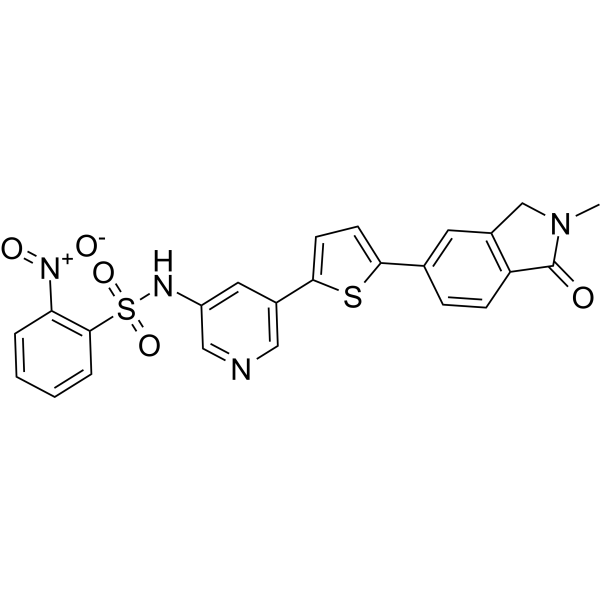
-
- HY-147547
-
|
|
Amyloid-β
|
Neurological Disease
|
|
SV5 is a potent anti-Alzheimer agent. SV5 can significantly protect SHSY-5Y cells against Aβ1-42-induced death. SV5 shows moderate antioxidant and good neuroprotective activities. SV5 shows the high stability in human plasma and the best pharmacological profile .
|
-
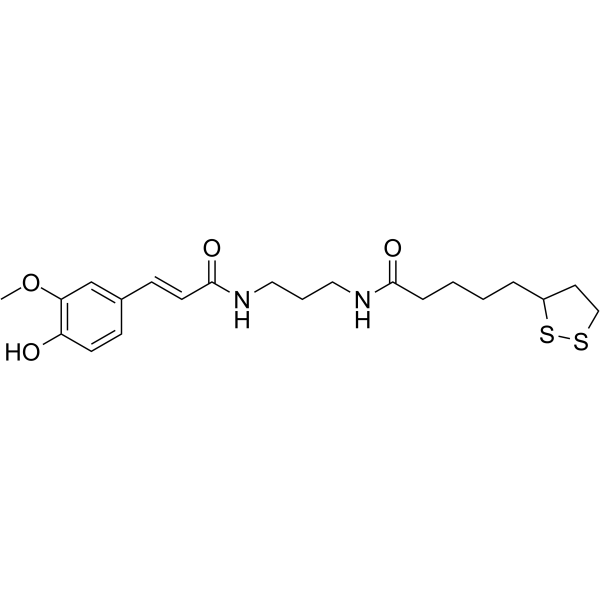
-
- HY-100313A
-
|
|
Farnesyl Transferase
HCV
|
Infection
Metabolic Disease
|
|
YM-53601, a squalene synthase inhibitor, reduces plasma cholesterol and triglyceride levels in vivo . YM-53601 inhibits squalene synthase derived from human hepatoma cells with an IC50 of 79 nM. Lipid-lowering agent . YM-53601 is also an inhibitor of farnesyl-diphosphate farnesyltransferase 1 (FDFT1) enzyme activity and abrogates HCV propagation .
|
-
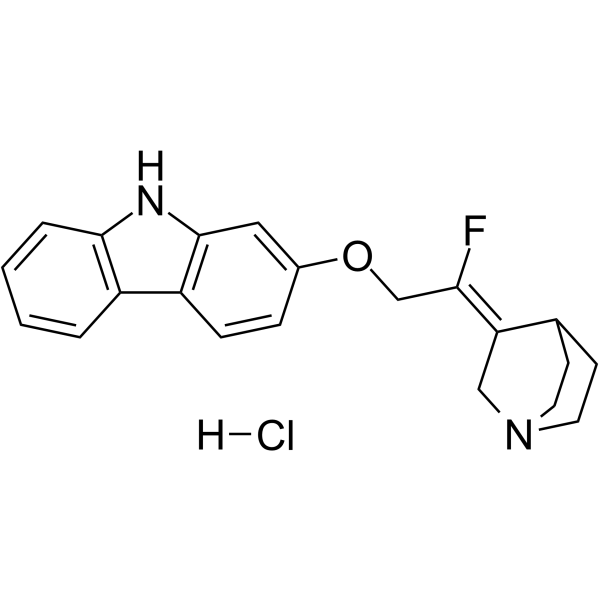
-
- HY-P3522
-
|
|
Integrin
|
Cancer
|
|
REDV is the minimal active sequence within the CS5 site of the alternatively spliced type III connecting segment (IIICS) region of fibronectin. REDV can mediate adhesion to the IIICS region of plasma fibronectin by binding the integrin alpha 4 beta 1(α4β1). REDV can be used for the research of cell adhesion .
|
-
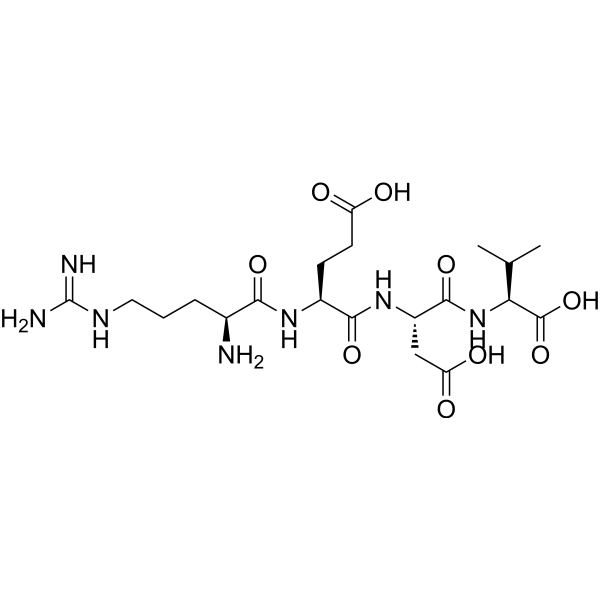
-
- HY-161247
-
|
|
5-HT Receptor
|
Metabolic Disease
|
|
5HT2A antagonist 2 is an orally active, selective antagonist for 5HT2A with IC50 of 14 nM. 5-HT2A antagonist 2 exhibits good chemical, hepatocyte, and plasma stability, without significant cytotoxicity in cell lines VERO, HFL-1, L929, NIH3T3, CHO-K1 .
|
-

-
- HY-P10281
-
|
|
Bacterial
|
Infection
|
|
RW3 is a small cationic hexapeptide with amphiphilic properties. RW3 targets the plasma membrane of bacteria and works by inhibiting cell respiration and cell wall synthesis. RW3 shows high biological activity against gram-positive bacteria and does not show significant cytotoxic or hemolytic effects in previous studies. RW3 quickly kills 97% of the initial colony forming units (CFU) within 10 minutes at twice the minimum inhibitory concentration (MIC). RW3 can be used in antimicrobial and antifungal studies .
|
-

-
- HY-P3522A
-
|
|
Integrin
|
Cancer
|
|
REDV TFA is the minimal active sequence within the CS5 site of the alternatively spliced type III connecting segment (IIICS) region of fibronectin. REDV TFA can mediate adhesion to the IIICS region of plasma fibronectin by binding the integrin alpha 4 beta 1(α4β1). REDV TFA can be used for the research of cell adhesion .
|
-

-
- HY-155193
-
|
|
Others
|
Inflammation/Immunology
|
|
XY-52 (Compound 32) is a Stimulation-2 (ST2) inhibitor, with an IC50 value of 5.68 μM in AlphaLISA assay, and 4.59 μM in HEK-Blue assay. XY-52 increases proinflammatory T-cell proliferation. XY-52 reduces the plasma sST2 and IFNγ biomarkers in the graft versus host disease (GVHD) mice model .
|
-

-
- HY-100313
-
|
|
Farnesyl Transferase
HCV
|
Metabolic Disease
|
|
YM-53601 free base, a squalene synthase inhibitor, reduces plasma cholesterol and triglyceride levels in vivo . YM-53601 free base inhibits squalene synthase derived from human hepatoma cells with an IC50 of 79 nM. Lipid-lowering agent . YM-53601 free base is also an inhibitor of farnesyl-diphosphate farnesyltransferase 1 (FDFT1) enzyme activity and abrogates HCV propagation .
|
-
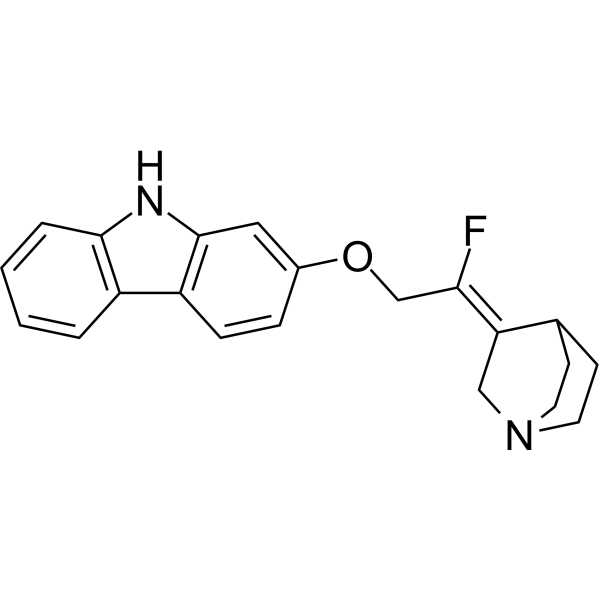
-
- HY-129611
-
|
|
Apoptosis
|
Inflammation/Immunology
Cancer
|
|
Bromelain is an anti-inflammatory agent derived from pineapple stem that acts through down-regulation of plasma kininogen, inhibition of Prostaglandin E2 expression, degradation of advanced glycation end product receptors and regulation of angiogenic biomarkers as well as antioxidant action upstream in the COX-pathway . Bromelain exhibits various fibrinolytic, antiedematous, antithrombotic, and anti-inflammatory activities. Bromelain also possesses some anticancerous activities and promotes apoptotic cell death .
|
-

-
- HY-155009
-
|
|
HIF/HIF Prolyl-Hydroxylase
|
Others
|
|
PHD2-IN-1 is a potent and orally active inhibitor of HIF prolyl hydroxylase 2 (PHD2) with an IC50 of 22.53 nM. PHD2-IN-1 can be used for anemia research .
|
-
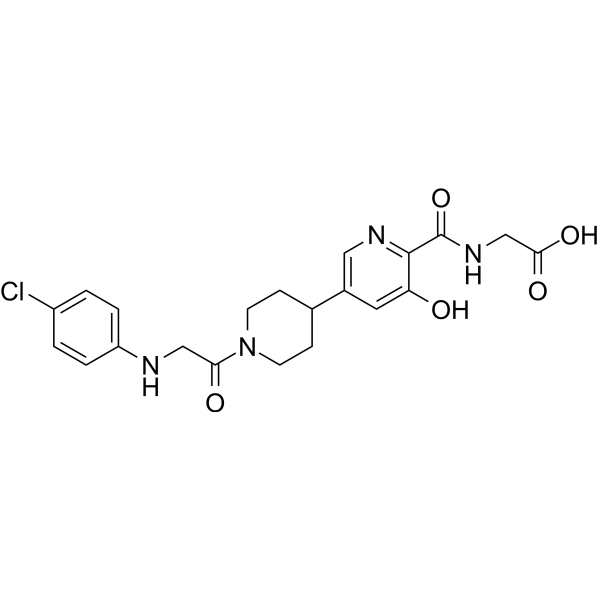
-
- HY-116461
-
|
CID2440433
|
GPR55
|
Neurological Disease
|
|
ML-184 (CID2440433) is a selective GPR55 agonist with an EC50 of 250 nM and exhibits >100-fold selectivity for GPR55 over GPR35, CB1 and CB2. ML-184 induces phosphorylation of ERK1/2 and translocation of PKCβII to the plasma membrane by activating GPR55 . ML-184(CID2440433) increases proliferation of neural stem cells and promotes neuronal differentiation in vitro .
|
-
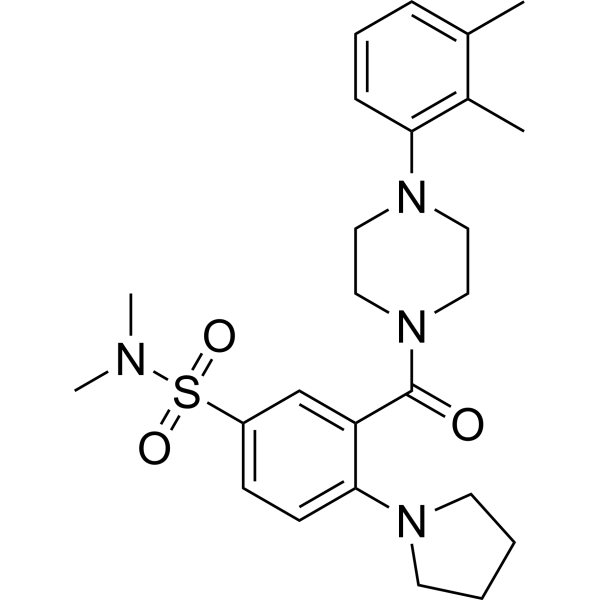
-
- HY-12765
-
|
E-3174; EXP-3174
|
Angiotensin Receptor
|
Cardiovascular Disease
|
|
Losartan Carboxylic Acid (E-3174), an active carboxylic acid metabolite of Losartan, is an angiotensin II receptor type 1 (AT1) antagonist. The Ki values are 0.97, 0.57, 0.67 nM for rat AT1B/AT1A and human AT1, respectively. Losartan Carboxylic Acid blocks the angiotensin II-induced responses in vascular smoothmuscle cells (VSMC). Losartan Carboxylic Acid elevates plasma renin activities and reduces mean arterial pressure .
|
-
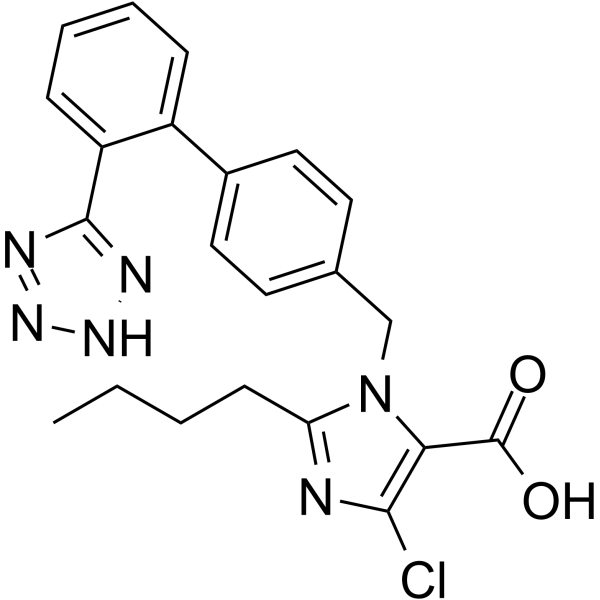
-
- HY-W130236
-
|
|
Cholinesterase (ChE)
|
Cancer
|
|
Methylene Violet 3RAX is a phenazine dye to stain the mitochondria of cells. Methylene Violet 3RAX can change the molecular structure of DNA, undermine the module of DNA, and induce the generation of the reactive singlet oxygen. Methylene Violet 3RAX shows inhibition for human erythrocyte AChE and human plasma BChE with an Kis of 1.58, 0.51 μM, respectively. Methylene Violet 3RAX has the potential for the research of potential photosensitizers for mitochondrial targeting action in PDT (photodynamic therapy) .
|
-

-
- HY-163004
-
|
|
Trk Receptor
|
Cancer
|
|
Type II TRK inhibitor 2 (compound 40l) is a selective type II TRK inhibitor with plasma stability and moderate hepatic microsomal stability. Type II TRK inhibitor 2 significantly inhibits Km-12, Ba/F3-TRKA G595R and Ba/F3-TRKA G667C cell proliferation (IC50: 4.1 nM, 41.5 nM, 1.4 nM). Type II TRK inhibitor 2 can be used to study NTRK fusion cancers .
|
-
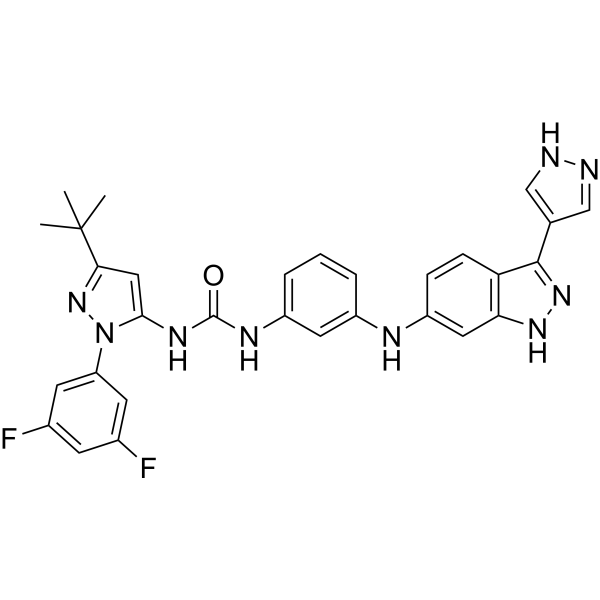
- HY-12765S1
-
|
|
Isotope-Labeled Compounds
Angiotensin Receptor
|
Cardiovascular Disease
|
|
Losartan carboxylic acid-d4 (hydrochloride) is deuterium labeled Losartan Carboxylic Acid. Losartan Carboxylic Acid (E-3174), an active carboxylic acid metabolite of Losartan, is an angiotensin II receptor type 1 (AT1) antagonist. The Ki values are 0.97, 0.57, 0.67 nM for rat AT1B/AT1A and human AT1, respectively. Losartan Carboxylic Acid blocks the angiotensin II-induced responses in vascular smoothmuscle cells (VSMC). Losartan Carboxylic Acid elevates plasma renin activities and reduces mean arterial pressure[1][2][3][4].
|
-
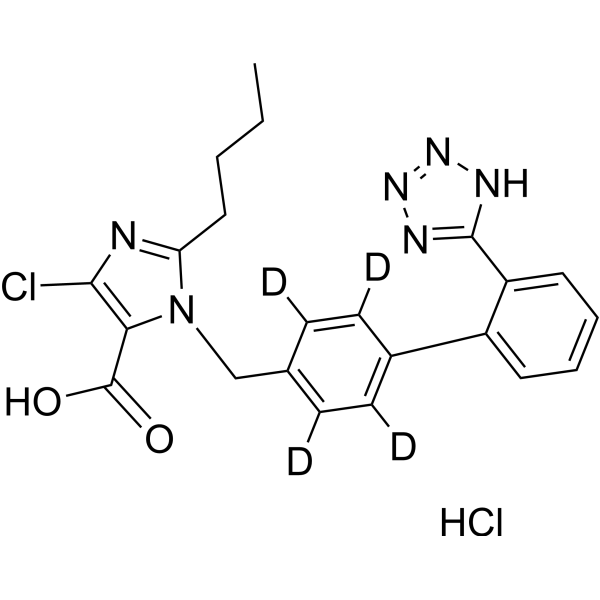
- HY-143877
-
|
|
HDAC
|
Cancer
|
|
NN-390 is a potent and selective HDAC6 inhibitor, with an IC50 of 9.8 nM. NN-390 penetrates the blood-brain barrier (BBB). NN-390 shows study potential in metastatic Group 3 MB (medulloblastoma) .
|
-

- HY-149028
-
|
|
Fluorescent Dye
|
Others
|
|
Mem-C1C18 is a polarity-sensitive fluorescent probe with excellent plasma membrane anchoring, high brightness and a sensitive response to environmental polarity by altering the fluorescence lifetime. Mem-C1C18 can be used to quantify changes in the polarity of the plasma membrane during iron death .
|
-

- HY-100401A
-
|
CS-505
|
Acyltransferase
|
Cardiovascular Disease
|
|
Pactimibe sulfate (CS-505) is a dual ACAT1/2 inhibitor with IC50s of 4.9 μM and 3.0 μM, respectively. Pactimibe sulfate (CS-505) inhibits ACAT with IC50s of 2.0 μM, 2.7 μM, 4.7 μM in the liver, macrophages and THP-1 cells, respectively . Pactimibe sulfate (CS-505) noncompetitively inhibits oleoyl-CoA with a Ki value of 5.6 μM. Moreover, Pactimibe sulfate (CS-505) obviously inhibits cholesteryl ester formation with an IC50 of 6.7 μM. Pactimibe sulfate (CS-505) possesses anti-atherosclerotic potential with lowering plasma cholesterol activity .
|
-
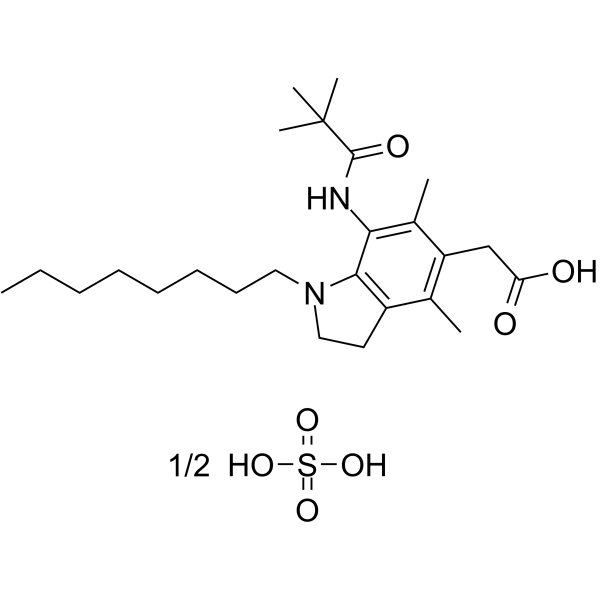
- HY-100401
-
|
CS-505 free base
|
Acyltransferase
|
Cardiovascular Disease
|
|
Pactimibe (CS-505 free base) is a dual ACAT1/2 inhibitor with IC50s of 4.9 μM and 3.0 μM, respectively. Pactimibe (CS-505 free base) inhibits ACAT with IC50s of 2.0 μM, 2.7 μM, 4.7 μM in the liver, macrophages and THP-1 cells, respectively . Pactimibe (CS-505 free base) noncompetitively inhibits oleoyl-CoA with a Ki value of 5.6 μM. Moreover, Pactimibe (CS-505 free base) obviously inhibits cholesteryl ester formation with an IC50 of 6.7 μM. Pactimibe (CS-505 free base) possesses anti-atherosclerotic potential with lowering plasma cholesterol activity .
|
-

- HY-163403
-
|
|
VEGFR
|
Cardiovascular Disease
Cancer
|
|
VEGFR-2-IN-43 (compound 16) is an orally active inhibitor of VEGFR2, with an IC50 of 39.91 μM. VEGFR-2-IN-43 can be used for wet age-related macular degeneration (w-AMD) disease research .
|
-
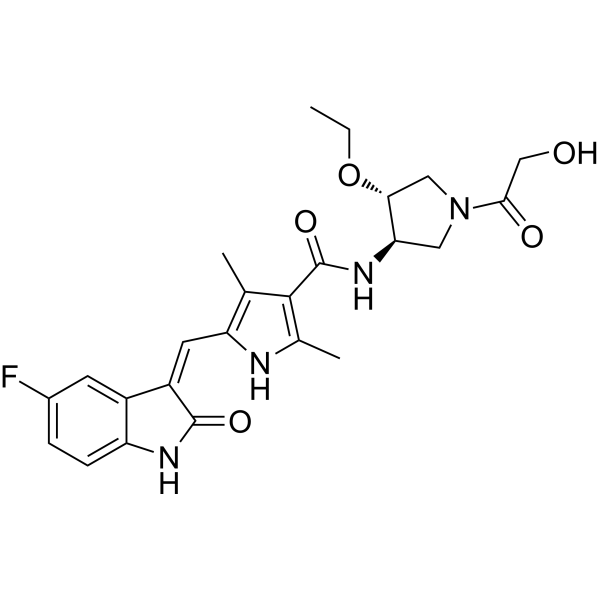
-
-
HY-L182
-
|
|
296 compounds
|
|
Fatty acids (FAs) are the main components of lipids. The synthesis of fatty acids mainly involves the Triglyceride (TG) cycle and De Novo Lipogenesis (DNL). Fatty acids which exist widely in organisms are components of cell membranes and play an indispensable role in cell signaling. In addition, FFAs can be taken up from circulating plasma by all mitochondria-containing cells, and they are metabolized by β-oxidation and the citric acid cycle to release large amounts of energy in the form of ATP. Abnormal fatty acid metabolism is associated with the occurrence and development of cardiovascular diseases, diabetes, fatty liver, hyperthyroidism, and other diseases.
MCE offers a unique collection of fatty acid compounds. Fatty Acids Compound Library is an important tool for the study of energy metabolism and drug development of metabolism-related diseases.
|
-
-
HY-L150
-
|
|
4,674 compounds
|
|
Membrane receptors, also known cell surface receptors or transmembrane receptors, are transmembrane proteins embedded into the plasma membrane which play an essential role in maintaining communication between the internal processes within the cell and various types of extracellular signals. They act in cell signaling by receiving (binding to) extracellular molecules, which are also called ligands. These extracellular molecules include hormones, cytokines, growth factors, neurotransmitters, lipophilic signaling molecules such as prostaglandins, and cell recognition molecules.
There are three kinds of membrane receptors: ion channel-linked receptors, enzyme-linked receptors and G-protein-linked receptors. They play important roles in keeping human normal physiologic processes. GPCRs and ion channels are important drug targets in drug discovery.
MCE provides a unique collection of 4,674 compounds targeting a variety of membrane receptors. MCE Membrane reeptor-targeted Compound Library can be used for membrane receptor-focused screening and drug discovery.
|
-
-
HY-L168
-
|
|
406 compounds
|
|
Extracellular vesicles (EVs) are small membrane binding structures that are released from cells into the surrounding environment and play a crucial role in mediating and regulating intercellular communication related to physiological and pathological processes. EVs are lipid membrane vesicles composed of proteins, lipids, and nucleic acids. EVs can be divided into several types based on their source, such as extracellular vesicles, microcapsules, and apoptotic vesicles. The size range of exosomes is 30-150nm, which are endocrine in multi vesicular endosomes (MVEs); microvesicles (50-1000nm) are secreted directly through extracellular interactions, thereby releasing plasma membrane vesicles. In contrast, apoptotic bodies are usually larger, ranging in size from 1 to 5 μ m. This is generated during programmed cell death. EV plays a crucial role in transmitting information between cells and influencing the behavior and function of receptor cells.
MCE designs a unique collection of 406 small molecules related to extracellular vesicles (EVs). It is a good tool to be used for research on metabolize, cancer and other diseases.
|
-
-
HY-L118
-
|
|
129 compounds
|
|
Sodium channels conduct sodium ions (Na+) through a cell's plasma membrane that are the source of excitatory currents for the nervous system and muscle. Na channels are classified according to the trigger that opens the channel for such ions, i.e. either a voltage-change (Voltage-gated, voltage-sensitive, or voltage-dependent sodium channel also called VGSCs or Nav channel) or a binding of a substance (a ligand) to the channel (ligand-gated sodium channels). Dysfunction in voltage-gated sodium channels correlates with neurological and cardiac diseases, including epilepsy, myopathies, pain and cardiac arrhythmias. Sodium channel blockers are used in the treatment of cardiac arrhythmia, pain and convulsion.
MCE offers a unique collection of 129 sodium channel blocker and antagonists, all of which have the identified inhibitory effect on sodium channels. MCE Sodium Channel Blocker Library can be used for neurological and cardiac diseases drug discovery and sodium channel research.
|
| Cat. No. |
Product Name |
Type |
-
- HY-156404
-
|
|
Dyes
|
|
PM-1, a derivative of Thioflavin-T (ThT; HY-D0218), is a small but highly specific plasma membrane (PM) fluorescent dye for specific and long-time membrane imaging of living and fixed cells. PM-1 is embedded directly into the cell membrane and exhibits a very long retention time on the plasma membrane with a half-life of approximately 15 h. PM-1 can be used in combination with protein labeling probes to study ectodomain shedding and endocytosis processes of cell surface proteins .
|
-
- HY-15924
-
|
MTT; Thiazolyl Blue Tetrazolium bromide; Methylthiazolyldiphenyl-tetrazolium bromide
|
Chromogenic Substrates
|
|
Thiazolyl Blue (MTT) is a cell-permeable and positively charged tetrazolium dye that is used to detect reductive metabolism in cells. Thiazolyl Blue is taken up by cells through the plasma membrane and then reduced to formazan by intracellular NAD (P) H-oxidoreductases. Thiazolyl Blue is frequently used in colorimetric assays to measure cell proliferation, cytotoxicity, and apoptosis .
|
-
- HY-D2318
-
|
|
Fluorescent Dyes/Probes
|
|
Flipper-TR 5 is a Flipper probe that can selectively label the plasma membrane of cells and exhibit excellent mechanosensitivity with negligible cytotoxicity .
|
-
- HY-D2301
-
|
|
Fluorescent Dyes/Probes
|
|
mgc(3Me)FL is the active fluorescent form of mgc(3Me)FDA (HY-D2300) after hydrolysis in cells. mgc(3Me)FL subcellularly localizes to the Golgi apparatus and is a visualized Golgi probe. mgc(3Me)FL also binds to the outer leaflet of the plasma membrane (PM), causing the plasma membrane to fluoresce .
|
-
- HY-D2263
-
|
|
Dyes
|
|
BODIPY-cholesterol conjugate-3 (compound 7) is a cholesterol analogue with a fluorescent BODIPY group. BODIPY-cholesterol conjugate-3 can be used to simultaneously visualize multiple cholesterol pools in cells, as it is primarily localized to the plasma membrane .
|
-
- HY-D0986
-
|
|
Fluorescent Dyes/Probes
|
|
TMA-DPH is a hydrophobic fluorescent membrane probe (Ex=355 nm; Em=430 nm). TMA-DPH is able to anchor on the cell surface and localize to different regions of the phospholipid bilayer. By analyzing the fluorescence polarization values of TMA-DPH in the plasma membrane and membrane substructures, the fluidity of the cell membrane can be determined .
|
-
- HY-136213
-
|
|
Dyes
|
|
Endoplasmic reticulum dye 1 is a promising live cell imaging agent for the detection of exocytotic events at the plasma membrane. Endoplasmic reticulum dye 1 shows low cytotoxicity, resistance to photobleaching , which is ideal for imaging either short- or long-time courses .
|
-
- HY-D1585
-
|
|
Fluorescent Dyes/Probes
|
|
BODIPY TR methyl ester is a lipophilic GFP Counterstain. BODIPY TR methyl ester dye readily permeates cell membranes and localizes in endomembranous organelles but not localize strongly in plasma membranes. BODIPY TR methyl ester is an excellent red fluorescent vital dye (Ex=568 nm, Em=625 nm), can be used to reveal the location and shapes of cell nuclei, the shapes of cells within embryonic tissues, as well as the bound aries of organ-forming tissues within the whole embryo .
|
| Cat. No. |
Product Name |
Type |
-
- HY-W142596
-
|
|
Drug Delivery
|
|
1,2-DImyristoyl-rac-glycero-3-phosphocholine (DMPC), a zwitterionic phospholipid, is chosen as a simple eukaryotic cell membrane, mimicking the neutral charge of the surface membrane of eukaryotic plasma membranes .
|
-
- HY-P1956
-
|
HSA
|
Native Proteins
|
|
Human serum albumin (HSA) is the most abundant protein in plasma and is a major determinant of plasma oncotic pressure. Human serum albumin exhibits antioxidant, anticoagulant, anti-inflammatory, anti-platelet aggregation activities as well as colloid osmotic action. Human serum albumin can block the inhibitory effect of GML on human T cells, providing protective function for T cells. Human serum albumin is also associated with cardiovascular diseases and can partially prevent the LPS (HY-D1056) induced oxidative stress, as well as the upregulation of NF-κB, NF-κB, and peroxynitrite (ONOO −) in the vascular wall, contributing to the reduction of blood pressure .
|
-
- HY-NP011
-
|
TRF
|
Native Proteins
|
|
Human transferrin (suitable for cell culture) is a glycoprotein with a branched sugar chain that mediates the transport of iron from plasma to cells .
|
-
- HY-108883
-
|
Fibrinolysins; Serum tryptase; TAL 05-00018
|
Biochemical Assay Reagents
|
|
Plasmin is an important protease present in blood that degrades many plasma proteins, including fibrin clots. Plasmin can also act as a potent regulator of the immune process and can directly interact with various cell types, including monocytes, macrophages, and dendritic cells .
|
-
- HY-NP018
-
|
FGA; FGA protein
|
Native Proteins
|
|
Bovine fibrinogen (from fibrinogen) is a native fibrinogen from bovine plasma. Bovine fibrinogen (from fibrinogen) can regulate the activation of NF-KB in endothelial cells and upregulate the expression of inflammatory chemokines MCP-1 .
|
| Cat. No. |
Product Name |
Target |
Research Area |
-
- HY-N7122
-
|
|
Endogenous Metabolite
|
Inflammation/Immunology
Cancer
|
|
Thymopentin is a biologically active peptide secreted mainly by the epithelial cells of thymic cortex and medulla. Thymopentin is an effective immunomodulatory agent with a short plasma half-life of 30 seconds. Thymopentin enhances the generation of T-cell lineage derived from human embryonic stem cells (hESCs) .
|
-
- HY-N7122A
-
|
|
Endogenous Metabolite
|
Inflammation/Immunology
Cancer
|
|
Thymopentin acetate is a biologically active peptide secreted mainly by the epithelial cells of thymic cortex and medulla. Thymopentin acetate is an effective immunomodulatory agent with a short plasma half-life of 30 seconds. Thymopentin acetate enhances the generation of T-cell lineage derived from human embryonic stem cells (hESCs) .
|
-
- HY-P4078
-
|
|
Peptides
|
Others
|
|
(Arg)9 biotin labeled is a cell-permeable peptide. (Arg)9 biotin labeled can be used for drug delivery. (Arg)9 biotin labeled can traverse the plasma membrane of eukaryotic cells .
|
-
- HY-P5345
-
|
|
Peptides
|
Others
|
|
KLA peptide is a biological active peptide. (a cationic amphipathic mitochondrial membrane disrupting peptide that induces programmed cell death by disrupting mitochondrial membrane, but cannot cross the plasma
membrane)
|
-
- HY-P4856
-
|
|
PKC
|
Endocrinology
|
|
pTH-Related Protein (1-40) (human, mouse, rat) stimulates calcium uptake in rat intestinal cells through PTHR1 receptor and PKCα/β signaling pathways. pTH-Related Protein (1-40) up-regulates parathyroid hormone 1 receptor (PTHR1) protein, four transcellular calcium transporters, potential vanillin member 6 (TRPV6), calcium-binding protein-D9K (CaBP-D9k), sodium-calcium Exchanger 1 (NCX1) and plasma membrane calcium ATPase 1 (PMCA1) .
|
-
- HY-P3826
-
|
|
Peptides
|
Neurological Disease
|
|
Chromogranin A (324-337), human is a peptide fragment of chromogranin A, it can be isolated from human ileal carcinoid tumor. Chromogranin A is a soluble glycoprotein stored with hormones and neuropeptides in secretory granules of most (neuro)endocrine cells and neurons, and it is also a plasma marker of neuroendocrine tumors .
|
-
- HY-P2967
-
|
|
Peptides
|
Others
|
|
α-Hemolysin (Staphylococcus aureus) is one of the most characteristic virulence factors secreted by Staphylococcus aureus, a polypeptide capable of destroying the host cell plasma membrane. After α-Hemolysin binds to the cell surface, its monomers assemble into a homoheptamer to form a front pore, which then transforms into a mature transmembrane pore water channel, allowing K + and Ca 2+ ion transport, leading to necrotic death of target cells .
|
-
- HY-122357
-
|
|
Adenylate Cyclase
|
Inflammation/Immunology
|
|
Bestim is a dipeptide, which exhibits high affinity to murine peritoneal macrophages, thymocytes, and plasma membranes isolated from these cells, with Kds of 3.1, 2.1, 18.6 and 16.7 nM, respectively. Bestim inhibits adenylate cyclase in the membranes of murine macrophages and thymocytes. Bestim exhibits immunomodulatory efficacy .
|
-
- HY-P10356
-
|
|
Peptides
|
Others
|
|
T100-Mut is a cell-permeable peptide whose N-terminus is conjugated with a myristoylated group, allowing it to penetrate and localize to the intracellular side of the plasma membrane, thus mimicking the topology of Tmem100-3Q. T100-Mut can alleviate TRPA1-mediated pain .
|
-
- HY-P3522
-
|
|
Integrin
|
Cancer
|
|
REDV is the minimal active sequence within the CS5 site of the alternatively spliced type III connecting segment (IIICS) region of fibronectin. REDV can mediate adhesion to the IIICS region of plasma fibronectin by binding the integrin alpha 4 beta 1(α4β1). REDV can be used for the research of cell adhesion .
|
-
- HY-P10281
-
|
|
Bacterial
|
Infection
|
|
RW3 is a small cationic hexapeptide with amphiphilic properties. RW3 targets the plasma membrane of bacteria and works by inhibiting cell respiration and cell wall synthesis. RW3 shows high biological activity against gram-positive bacteria and does not show significant cytotoxic or hemolytic effects in previous studies. RW3 quickly kills 97% of the initial colony forming units (CFU) within 10 minutes at twice the minimum inhibitory concentration (MIC). RW3 can be used in antimicrobial and antifungal studies .
|
-
- HY-P3522A
-
|
|
Integrin
|
Cancer
|
|
REDV TFA is the minimal active sequence within the CS5 site of the alternatively spliced type III connecting segment (IIICS) region of fibronectin. REDV TFA can mediate adhesion to the IIICS region of plasma fibronectin by binding the integrin alpha 4 beta 1(α4β1). REDV TFA can be used for the research of cell adhesion .
|
| Cat. No. |
Product Name |
Target |
Research Area |
-
- HY-P9960
-
|
Ocrevus
|
CD20
|
Inflammation/Immunology
|
|
Ocrelizumab is an anti-CD20 antibody that depletes circulating immature and mature B cells but spares CD20-negative plasma cells. The effector mechanisms of Ocrelizumab are complement-dependent cytotoxicity and antibody-dependent cellular cytotoxicity. Ocrelizumab is the first monoclonal antibody for secondary primary progressive multiple sclerosis (PPMS) .
|
| Cat. No. |
Product Name |
Category |
Target |
Chemical Structure |
| Cat. No. |
Product Name |
Chemical Structure |
-
- HY-12765S1
-
|
|
|
Losartan carboxylic acid-d4 (hydrochloride) is deuterium labeled Losartan Carboxylic Acid. Losartan Carboxylic Acid (E-3174), an active carboxylic acid metabolite of Losartan, is an angiotensin II receptor type 1 (AT1) antagonist. The Ki values are 0.97, 0.57, 0.67 nM for rat AT1B/AT1A and human AT1, respectively. Losartan Carboxylic Acid blocks the angiotensin II-induced responses in vascular smoothmuscle cells (VSMC). Losartan Carboxylic Acid elevates plasma renin activities and reduces mean arterial pressure[1][2][3][4].
|
-

Your information is safe with us. * Required Fields.
Inquiry Information
- Product Name:
- Cat. No.:
- Quantity:
- MCE Japan Authorized Agent:
































































